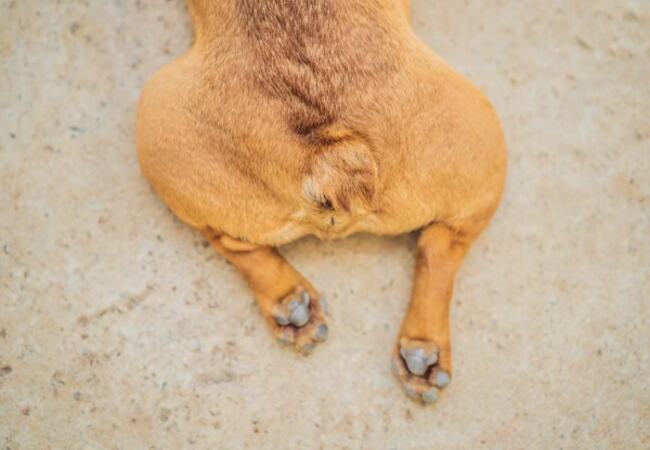Vet’s 2025 Guide to Recessed Vulva in Dogs 🩺 Prevention, Symptoms & Fixes

In this article
Vet’s 2025 Guide to Recessed Vulva in Dogs 🩺 Prevention, Symptoms & Fixes
By Dr. Duncan Houston BVSc
💡 What Is a Recessed Vulva?
A recessed or hooded vulva occurs when extra skin folds around the vulva partially or completely cover it, creating a warm, moist pocket. This structural trait can predispose dogs to secondary problems like skin infections, vaginitis, urinary tract infections (UTIs), and even incontinence.
⚠️ Who Gets It?
- Most seen in medium-to-large breeds; obesity is a major risk factor due to increased fat and skin folds.
- Can occur in any dog, spayed or intact; early spaying is suspected but not confirmed genetically.
- Puppies may outgrow structural forms but still require vigilance.
🚩 Symptoms & Complications
- Perivulvar skin irritation: redness, moisture, dark or black staining, foul odor, licking, scooting.
- Chronic or recurrent vaginitis—mucus, discharge, itchiness.
- UTI symptoms: frequent urination, accidents, straining, bloody or smelly urine.
- Urinary incontinence due to trapped urine in folds.
- Potential kidney infections if untreated.
🧪 Diagnosis Steps
- Visual & physical exam reveals missed vulva location.
- Skin cytology (tape or swab) to check bacteria or yeast.
- Urinalysis + culture for UTIs.
- Bloodwork to rule out endocrine issues.
- Imaging (ultrasound/X-ray) for bladder/UT abnormalities.
🩺 Treatment Approaches
1. Medical Management & Hygiene
- Daily cleaning: gently wipe and dry folds with medicated wipes or baby wipes – 1–2× daily.
- Topical antimicrobials (shampoos, wipes, sprays) to treat dermatitis.
- Systemic antibiotics for confirmed skin or bladder infections.
- Weight loss programs for overweight dogs may reduce fold severity.
2. Surgical Correction (Vulvoplasty/Episioplasty)
- Recommended for dogs with recurrent infections or dermatitis despite medical therapy.
- The procedure involves removing excess skin around vulva to restore normal anatomy and ventilation.
- Pre-op: resolve current infections; use antibiotics templated by culture.
- Post-op care: antibiotics, pain control, cone use, restricted exercise for 10–14 days.
- Success rates are high; recurrence possible if weight increases again.
📅 Post-treatment Prognosis & Follow Up
- Medical management may control symptoms but not correct anatomy—ongoing hygiene is key.
- Surgery often resolves the issue, with rapid recovery, low complication rate.
- Regular follow-up: exam, urinalysis 2–4 weeks post-treatment; weight and hygiene monitoring.
- Prevention: maintain healthy weight, cleanliness, and treat early signs of infection.
🏡 Ask A Vet Home Support
- Daily logs: check for odor, moisture, licking, accidents 📸.
- Set reminders: hygiene routines, medication, vet rechecks 🕒.
- Upload photos of skin and urination habits for remote vet review.
- Alerts for infection signs: bleeding, foul odor, incontinence episodes.
- Educational tips: how to clean safely, weight loss plans, signs to watch.
🔍 Key Takeaways
- Recessed vulva is common in medium/large and overweight dogs, but can affect any ⬆️.
- Moisture trapping leads to dermatitis, vaginitis, UTIs, and sometimes incontinence ☔.
- Diagnosis is visual + lab-based; treatment ranges from hygiene to veterinary surgery.
- Surgery is curative for many, but maintenance remains important 🧼.
- Ask A Vet supports detection, treatment adherence, and long-term wellness for owners.
🩺 Conclusion ❤️
In 2025, treating a recessed vulva means combining modern hygiene-based care, responsible weight management, and surgery when needed. With Ask A Vet’s home-support app—reminders, photo reviews, vet connectivity—owners can confidently manage their dog’s comfort, infection risk, and urinary health. A few small changes at home can make a world of difference for your pup! 🐾✨
Visit AskAVet.com and download the Ask A Vet app to log symptoms, schedule hygiene routines, upload recovery photos, and stay connected with your vet—right from your phone. 📲






